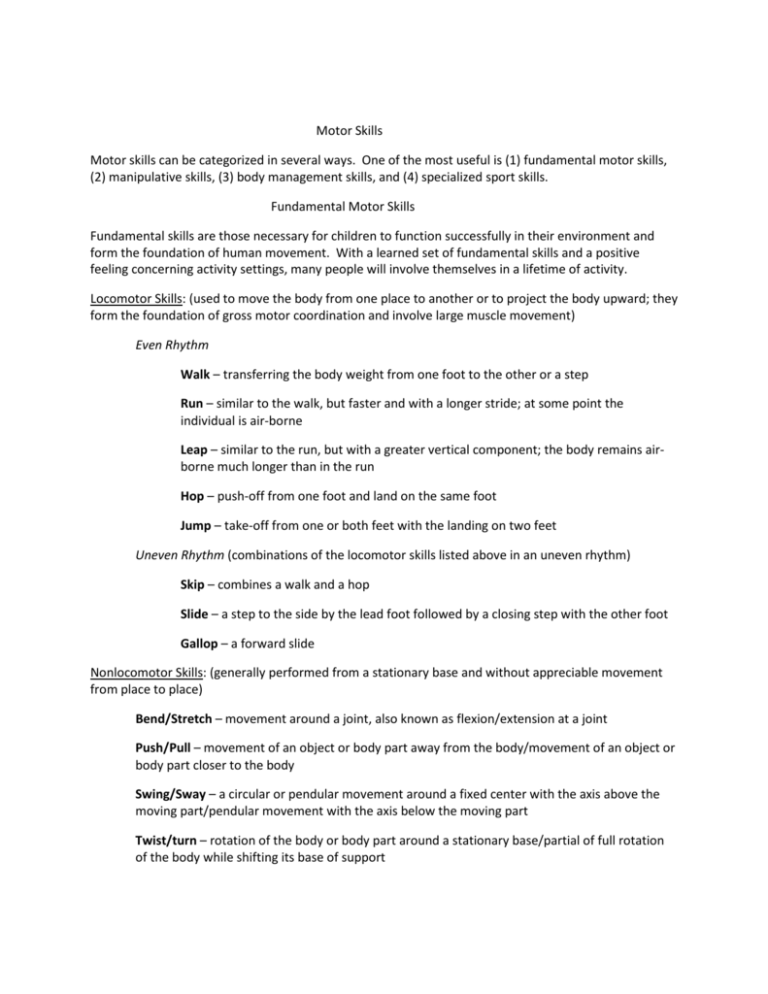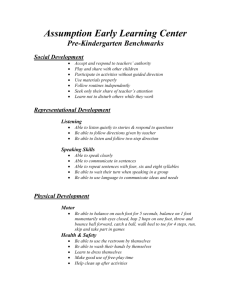Motor skills
advertisement

Motor Skills Motor skills can be categorized in several ways. One of the most useful is (1) fundamental motor skills, (2) manipulative skills, (3) body management skills, and (4) specialized sport skills. Fundamental Motor Skills Fundamental skills are those necessary for children to function successfully in their environment and form the foundation of human movement. With a learned set of fundamental skills and a positive feeling concerning activity settings, many people will involve themselves in a lifetime of activity. Locomotor Skills: (used to move the body from one place to another or to project the body upward; they form the foundation of gross motor coordination and involve large muscle movement) Even Rhythm Walk – transferring the body weight from one foot to the other or a step Run – similar to the walk, but faster and with a longer stride; at some point the individual is air-borne Leap – similar to the run, but with a greater vertical component; the body remains airborne much longer than in the run Hop – push-off from one foot and land on the same foot Jump – take-off from one or both feet with the landing on two feet Uneven Rhythm (combinations of the locomotor skills listed above in an uneven rhythm) Skip – combines a walk and a hop Slide – a step to the side by the lead foot followed by a closing step with the other foot Gallop – a forward slide Nonlocomotor Skills: (generally performed from a stationary base and without appreciable movement from place to place) Bend/Stretch – movement around a joint, also known as flexion/extension at a joint Push/Pull – movement of an object or body part away from the body/movement of an object or body part closer to the body Swing/Sway – a circular or pendular movement around a fixed center with the axis above the moving part/pendular movement with the axis below the moving part Twist/turn – rotation of the body or body part around a stationary base/partial of full rotation of the body while shifting its base of support Manipulative Skills Manipulative skills are those in which a child handles an object with the hands, feet, or other body parts. These skills are basic to a number of specialized sport skills. Equipment such as hoops, wands, balloons, beanbags, rings, Lummi sticks, various types of balls, Frisbees, scoops, scarves, long and short ropes, parachutes and panelchutes, ribbons, scooters, and footbags are some of the objects used to help students develop manipulative, rhythmical and locomotor skills. They also help students to develop hand-eye and foot-eye coordination and dexterity. Throwing (three types) Vertical Throw – the ball is held in front of the body in the fingers of the two hands, with one hand on either side of the ball; lower the ball, hips, and knees to begin the throw; raise the arms and extend the legs releasing the ball above shoulder height; follow through with the arms straight up Underhand Throw – performed using one of two hands to support the ball; hold the ball in the fingers of one or two hands at one side of the body; transfer the body weight to the supporting foot on the backswing; step forward on the opposite foot on the throw; keep your eye on the target; release the ball and follow through in the direction of the target Overhand Throw – (mature throwing form) grip the ball with the fingers of the throwing hand; turn the opposite side of the body towards the target, shifting your weight to the back foot; step forward on the opposite foot, leading with the elbow as the throwing arm moves forward; extend the arm and release the ball; follow through in the direction of the target and finally down across the body Catching – move in line with the object as it approaches, eyes fixed on the object, reaching out with the arms towards it, and on contact, bring the hands in to absorb the force Striking – a variety of body parts and implements may be used to strike an object; the object to be struck may be moving or stationary; hand-eye and/or foot-eye coordination are important for success Bouncing (Dribbling) – pushing the ball with the finger pads or inside/outside of the feet Striking with the Hand or Implement – standing in a forward/backward stride position, swing the arm backwards, then move the arm forward making contact when optimum speed has been achieved, and follow through in the intended direction; transfer weight from the rear foot to the front foot as contact is made with the object; practice in striking begins with the hands and progresses to paddles, bats, sticks, and racquets Striking with the Feet – the body leans slightly forward with the head up, the kicking foot is drawn back and then down and forward to contact the ball; the contact leg is straight, and follows through in the direction of the target; the ball may be stationary or moving; dribbling with the feet is also possible by alternately kicking the ball with the inside of the feet, keeping the ball relatively close to the kicker. Body Management Skills Body management skills are required for control of the body in a variety of situations. They require an integration of agility, coordination, strength, balance, and flexibility. Starting – bend knees and lean forward; push-off by forcefully extending the legs; use arms to drive the body forward in the direction of the start Stopping – place one foot out in front of the other in a forward/backward-stride position; bend knees, hips, and ankles to absorb the force of the movement; extend the arms to the sides to aid in balance; the body weight is brought back and down over the base of support Dodging – quickly shift the body or body parts away from an object or a person in the direction that you want to go; bend knees, push-off and move in the new direction Landing – gradually absorb the force as body parts contact a surface by bending knees ankles, and hips (or other body parts); keep body weight over your base of support; extend arms to the side for balance when landing on your feet Fleeing/Chasing/Tagging – moving under control by making a preliminary movement in one direction (faking) before determining the final path/chase by focusing on the waistline of the dodger to negate the fake/tag between the knees and shoulders in a gentle but firm manner Large Apparatus Activities – these activities offer the student an opportunity to learn body management skills while free of ground support; included are rope climbing activities, bench activities, balance beam activities, and jumping boxes Small Apparatus Activities – these activities help develop body control in space and on the ground; included are magic ropes, individual mats, and gym scooters Specialized Sport Skills The specialized sport skills discussed refer only to some of those that would be taught at the EC-6 level. Most modified sport skills are taught in grades 3-6, with the exception of the elementary gymnastic skills of stunts and tumbling and some balance beam work. Specialized sport skills have a rhythm and should be practiced at normal speed. The following specialized sport skills are listed for information only and reflect the magnitude of the expertise needed to be an effective physical educator. Gymnastics Stunts and tumbling – Animal walks, individual stunts, partner and group stunts, individual tumbling skills, individual balances, partner balances, etc. Balance beam – (heights range from a few inches to four feet) mounts, moving on the beam, turns, tumbling movements, balances, and dismounts Parallel bars – (heights may be fixed at 30 inches or may be adjustable) mounts, balances, travel/swings, and dismounts Horizontal bars – (about shoulder height) mounts, stunts, and dismounts Uneven parallel bars – mounts, balances, swinging/moving, and dismounts Vaulting – (spring board, Swedish boxes, benches or horses) mounts and vaults Track, Field, and Cross-Country Running Events Starts Sprints Middle Distance Distance Relays Hurdles Field Events Jumping – broad jump or standing jump, long jump, and high jump Throwing – shot put (a softball may ball may be used); javelin and discus are seldom taught at the elementary level Cross-Country Marked courses Unmarked courses Softball Throwing Pitching Catching and Fielding Batting Base running Soccer Offensive Skills Passing Kicking Controlling Dribbling Volleying (including heading) Shooting Defensive Skills Tackling Jockeying Throw- Ins Goalkeeping Punting (goalkeeper only) Basketball Shooting (one-hand shot, lay-up, and free throw) Dribbling Passing Catching Defending Stopping Pivoting Feinting (faking) Racquet Sports (tennis, badminton, racquetball, handball or wall ball) Grip Ready position Forehand Backhand Serve Volley Football Forward pass Lateral pass Catching Handing off the ball Carrying the ball Running and dodging Centering the ball Stance Blocking Punting Hockey Gripping and carrying the stick Passing Forward pass Receiving Stick handling Shooting Face-off Goalkeeping Volleyball Serving Setting Forearm pass Blocking Spiking Critical Thinking Questions 1. 2. 3. 4. Which TEKS do motor skills address? How familiar are you with the categories of motor skills? Do you have a clear delineation of the mechanics of the various skills? Would you be able to detect errors and correct skills of students?







